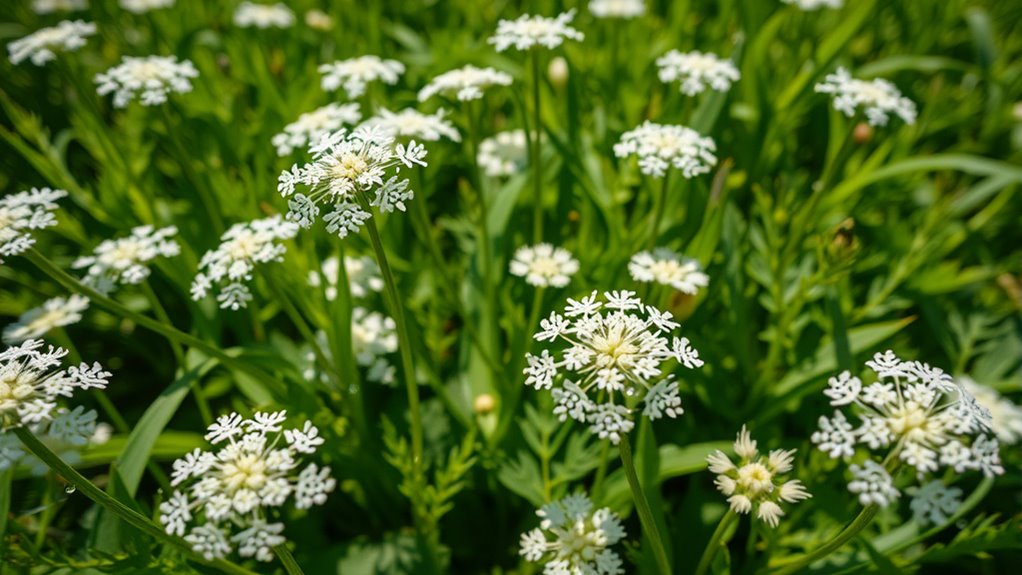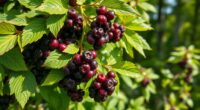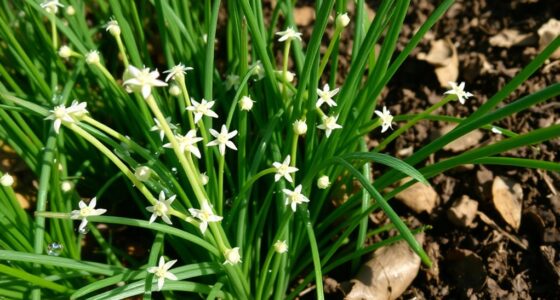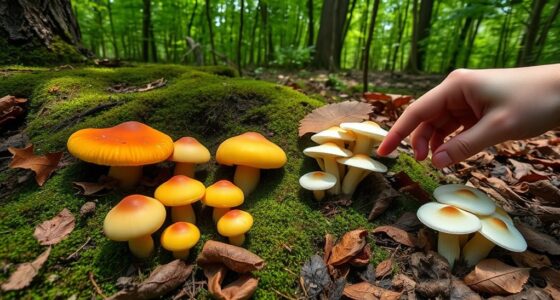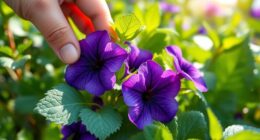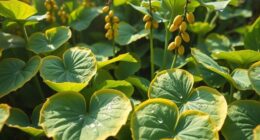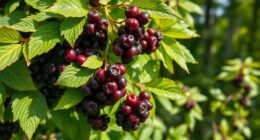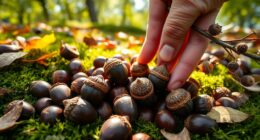To forage safely for wild carrots like Queen Anne’s Lace, learn to identify its distinctive flat-topped white flower umbels, fern-like leaves, and carrot-shaped root. Be sure to differentiate it from toxic plants like poison hemlock by checking for bristly stems, an aroma similar to carrots, and the inward-curving umbels. Since habitat and careful harvesting are key, knowing more about safe practices can guarantee a rewarding foraging experience. Keep exploring to discover how to do it responsibly.
Key Takeaways
- Identify Queen Anne’s Lace by its tall, bristly stems, fern-like leaves, and flat-topped white flower umbels, often with a central dark flower.
- Harvest roots early in the season, using sturdy tools, and ensure proper identification to avoid toxic look-alikes like poison hemlock.
- Use gloves when handling plants to prevent allergic reactions and wash roots thoroughly before cooking or consuming.
- Forage in open, sunny areas with sandy or gravelly soils, and harvest sustainably to protect plant populations and local ecosystems.
- Incorporate flowers into salads, desserts, or main dishes, and practice responsible harvesting to maintain ecological balance.
Recognizing Queen Anne’s Lace in the Wild
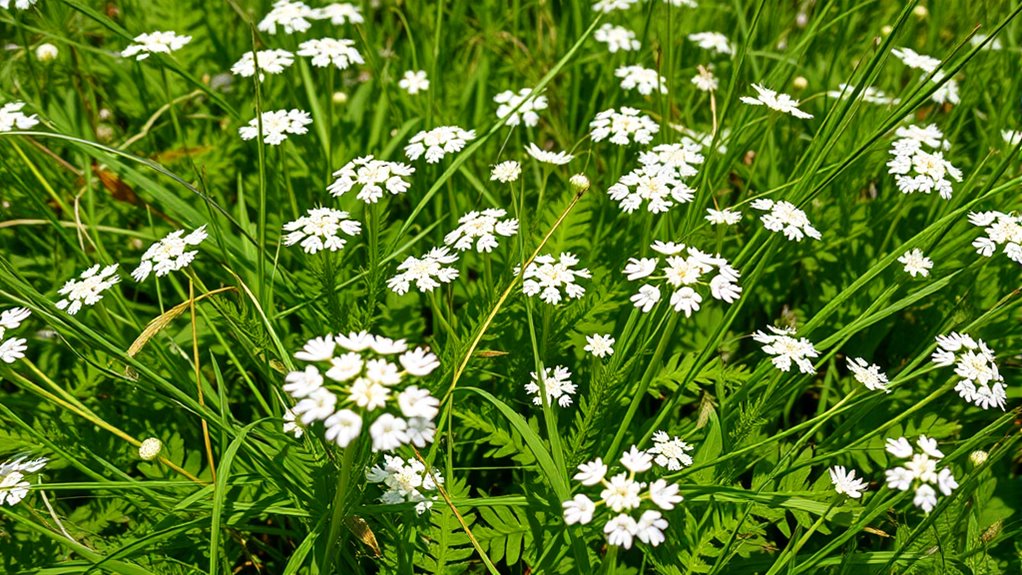
How can you identify Queen Anne’s Lace in the wild? First, look for its tall, erect stems that reach one to three feet, covered in bristly hairs with vertical veins. The leaves are alternate, compound, and divided into narrow, fern-like segments, measuring up to ten inches long and several inches wide, giving a lacy appearance. The plant produces flat-topped umbels, two to five inches across, filled with tiny white flowers about 1/8 inch in size. Some umbels may feature a central dark red or purple flower. As it matures, the umbels often curve inward into a bird’s nest shape, which is a characteristic visual cue for identification. The stems are typically bare, supporting the umbrella clusters, and the roots emit a carrot-like scent, hinting at its edible potential. Additionally, the mature umbels often develop a distinctive bird’s nest shape, aiding in identification. Recognizing the plant’s distinctive features can help distinguish Queen Anne’s Lace from similar-looking plants in the wild. Observing the plant’s growth habit can also be a helpful identification factor, as it tends to grow in open, sunny areas, often along roadsides and fields. Learning about home decor-inspired plant patterns can enhance your appreciation of natural motifs in garden design and decoration.
Distinguishing Features From Toxic Look-Alikes
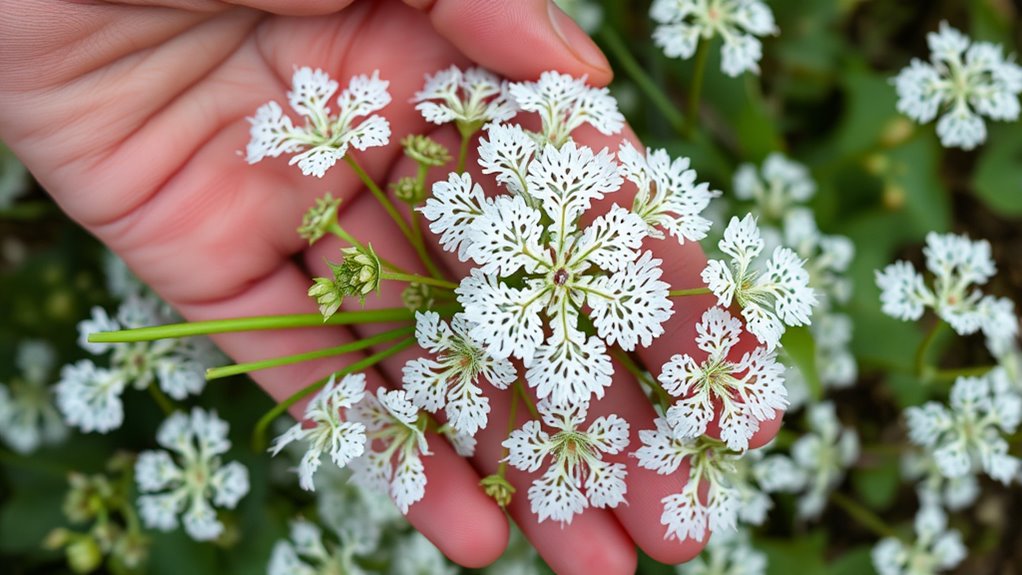
To accurately identify Queen Anne’s Lace and avoid confusing it with toxic look-alikes, focus on its key physical features. Look for hairy stems, a distinguishing trait that sets it apart from poison hemlock, which has smooth stems.
Identify Queen Anne’s Lace by its hairy stems and carrot-like scent to distinguish it from toxic look-alikes.
Examine the flowers; Queen Anne’s Lace has tiny white flowers arranged in a flat-topped umbel, usually 2 to 5 inches across, often becoming concave or bird’s nest-shaped as they age. Some umbels feature a single dark red or purple flower at the center.
Check the leaves and bracts; lower bracts have three prongs, and the leaves resemble those of domestic carrots. The scent is also a clue—Queen Anne’s Lace has a carrot-like aroma, unlike the scentless toxic look-alikes.
Understanding the importance of artistic representation can enhance the way you observe and document these plants for accurate identification. Always verify multiple features before foraging.
Best Habitats for Finding Wild Carrots
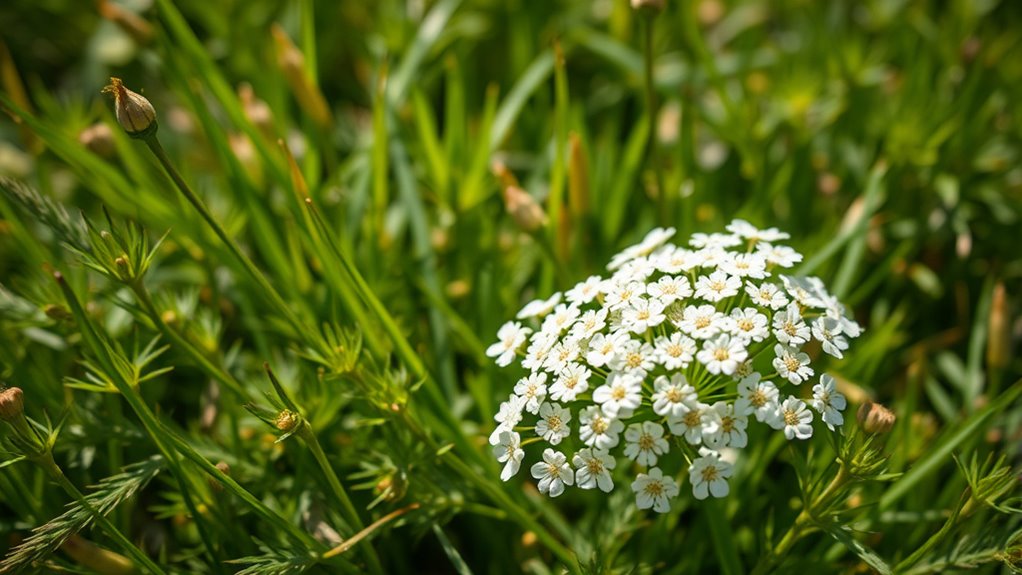
Wild carrots thrive in open, sunny environments where they can receive plenty of light to fuel their growth. Look for them in dry, sunny areas like open fields, meadows, and along roadsides. They often grow in disturbed sites and low-vegetation zones, where competition is minimal.
They prefer gravelly or sandy soils but can also grow in harder clay soils, provided they get full sun and regular moisture. Wild carrots are highly adaptable and can flourish in various habitats, including waste places, pastures, hayfields, and woodland edges. Residency requirements can influence where these plants are found, as they often grow near human habitations or in areas with minimal legal restrictions. Additionally, their ability to spread aggressively through seed dispersal makes them common in areas with minimal canopy cover.
They spread aggressively through seed dispersal, often attaching to animal hair. Disturbances like mowing promote growth, so areas with minimal canopy cover and periodic disturbance are ideal spots to find these resilient plants. Their seed dispersal mechanisms are enhanced by their seed attachment to animals and vehicles, aiding their widespread distribution. Furthermore, their resilience is supported by their ability to grow in a wide range of soil types, making them a common sight in various environments.
Harvesting and Preparing Queen Anne’s Lace Safely
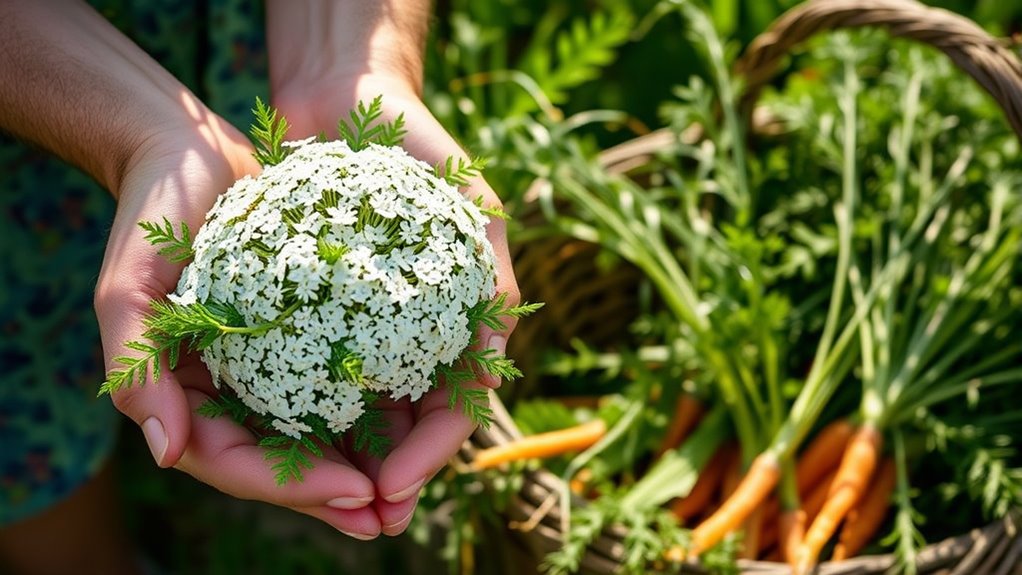
When harvesting Queen Anne’s lace, it’s essential to correctly identify the plant and handle it carefully to guarantee safety and quality. Look for its basal rosette of leaves and long taproots, which can reach six inches. Harvest roots early in the season before they become fibrous, using a sturdy shovel or digging stick to carefully extract them without damage. Wash roots thoroughly and trim away any tough fibers before cooking—boiling, roasting, or sautéing them like carrots. When handling the plant, wear gloves to prevent allergic reactions or photosensitivity, and avoid collecting from contaminated areas. For flowers, pick when they lie flat and use in recipes like fritters. Proper identification and cautious handling help ensure a safe, enjoyable foraging experience. Additionally, using pimple patches can be an effective method for treating skin blemishes if you encounter skin sensitivities from handling plants. Being aware of plant toxicity is crucial for safe foraging practices, especially with wild plants. It’s also beneficial to familiarize yourself with safe harvesting techniques to minimize environmental impact and ensure sustainable foraging. Incorporating knowledge of optimal harvesting times can further improve the quality and safety of your foraged foods.
Culinary Uses and Recipes for Wild Carrots
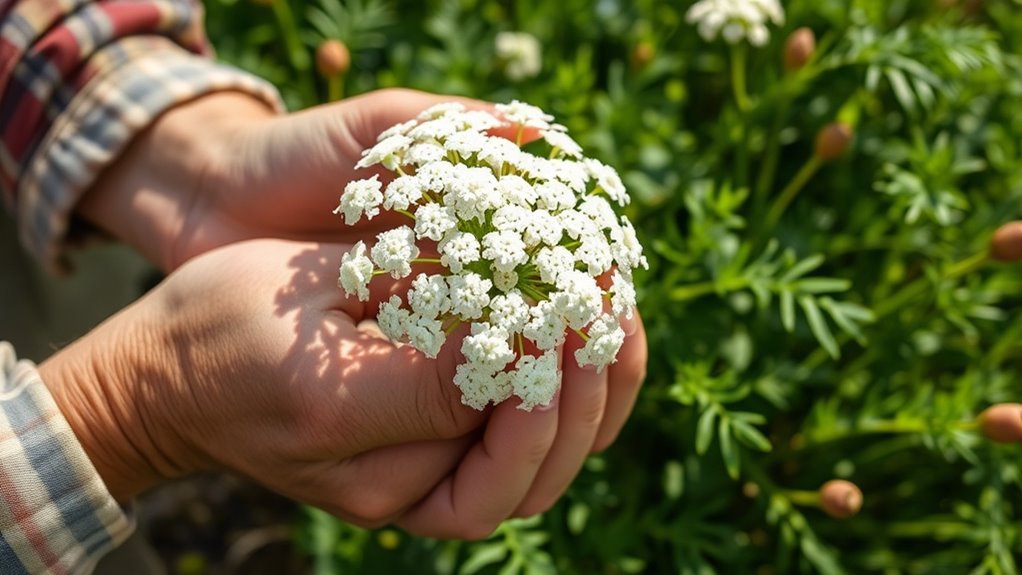
You can enjoy Queen Anne’s Lace in a variety of culinary applications, thanks to its delicate flavor and versatility. Add the flowers to salads or use them as a garnish for soups to bring a subtle, decorative touch. Caramelize the flowers for desserts like crème brûlée or infuse them into jellies and syrups to create unique flavors. You can also make gluten-free or paleo fritters using the flowers, adding a crispy texture. Wild carrot seeds can be used to coat fish or garnish glazed carrots, providing a nutty, earthy flavor. Use seeds sparingly, as they can have side effects. Queen Anne’s Lace also enhances main dishes like glazed carrots, fish, chicken, or pork, adding both flavor and visual appeal. Proper installation and maintenance ensure their optimal flavor and safety when used in cooking. Additionally, understanding the toxicity of certain parts of the plant helps prevent potential health issues. Incorporating educational toy principles such as safe handling and proper identification can also be beneficial when foraging wild plants. Recognizing the plant’s personality traits can aid foragers in correctly identifying it and avoiding look-alikes. Being aware of the plant’s distribution and habitat can also help ensure accurate identification and sustainable foraging practices.
Ethical Foraging and Environmental Considerations
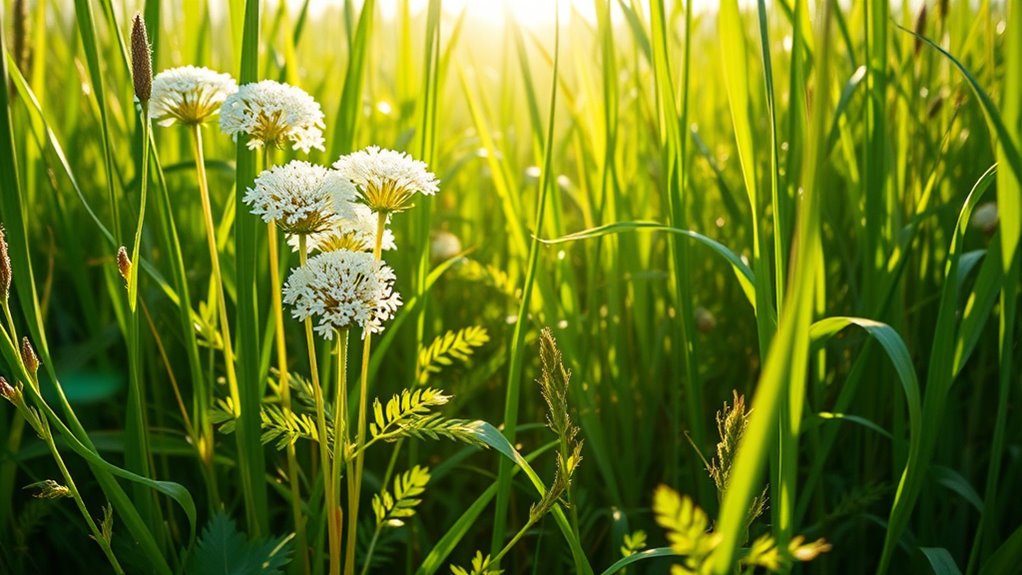
Enjoying wild carrots responsibly means understanding the importance of ethical foraging and respecting the environment. First, always identify plants correctly to avoid poisonous lookalikes like Poison Hemlock. Proper identification is crucial, so consulting reliable resources or experts can help ensure safe foraging practices. Harvest only what you need, leaving enough for the plant to regenerate and supporting the ecosystem. Handle plants carefully with gloves to prevent skin reactions. Choose safe harvesting spots, avoiding contaminated areas or those disturbed by human activity. Focus on selective harvesting—only take roots or flowers when appropriate—and check plants for damage or disease beforehand. Be mindful of wildlife that depends on these plants and avoid over-harvesting to protect local biodiversity. Additionally, understanding local regulations ensures you forage responsibly and ethically. Recognizing road safety signs while foraging in unfamiliar areas can help prevent accidents and ensure safe navigation through natural environments. By practicing sustainable foraging, you help preserve plant populations and maintain ecological balance for future foragers.
Frequently Asked Questions
Can Queen Anne’S Lace Be Cultivated Intentionally in Home Gardens?
Yes, you can cultivate Queen Anne’s Lace intentionally in your home garden. It’s easy to grow since it thrives in full sun, tolerates poor soils, and is drought-resistant.
Sow seeds in early fall or directly into the ground, and let it self-seed. Keep an eye on its spread, deadhead if needed, and enjoy its delicate flowers that attract pollinators.
It’s a hardy, low-maintenance addition to your garden.
Are There Any Health Risks Associated With Consuming Wild Carrots?
You should be aware that consuming wild carrots carries health risks. Misidentification with poisonous plants like hemlock can be deadly, so proper identification is essential.
Handling the plant may cause skin rashes if exposed to sunlight.
Large quantities might impact your blood pressure or interact with medications such as lithium or antihypertensives.
To stay safe, wear gloves, avoid sun exposure after handling, and consult a healthcare professional before eating wild carrots.
How Do Seasonal Changes Affect the Plant’S Appearance and Edibility?
Oh, the joys of seasonal change—Queen Anne’s Lace transforms from lush, green leaves in early spring to delicate white umbels in summer, before curling into seed nests.
You’ll find the roots edible in the first year, but beware as the plant matures. Remember, its appearance shifts, making identification tricky.
Stay cautious, harvest carefully, and avoid the toxic lookalikes lurking in disguise—nature’s own game of hide-and-seek.
What Are the Best Tools for Safely Harvesting Wild Queen Anne’S Lace?
To harvest Queen Anne’s Lace safely, you’ll want to use the right tools. A sturdy shovel works best for digging up the taproots, especially for larger plants. A digging stick can be helpful for smaller or tricky spots.
Use scissors or clippers to snip the flower clusters if you’re harvesting for decorative purposes.
Always wear gloves and long sleeves to protect your skin from potential irritation, and carry a container to collect your harvest.
Is It Legal to Forage for Wild Carrots in Public Lands?
You’re wondering if it’s legal to forage for wild carrots on public lands. Regulations vary widely depending on the location, with many national parks banning foraging altogether.
Some national forests and preserves allow limited harvesting, but you must check specific rules first.
Fines for illegal foraging can be hefty, often starting at $500.
Always obtain permission where necessary and guarantee proper plant identification to avoid penalties and protect ecosystems.
Conclusion
As you walk these wild paths, remember you’re like a careful gardener tending a delicate garden of nature’s secrets. Each step, each plant, holds stories passed down through time—requiring patience, respect, and keen eyes. By foraging responsibly, you become a steward of this living tapestry, preserving its beauty and balance. Like a gentle river carving its course, your mindful journey nurtures both your spirit and the wild landscape, ensuring its treasures endure for generations to come.

